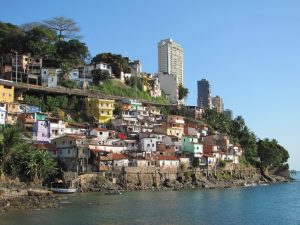
“This process of forgetting is essential to the social construction of the city, creating in essence two cities, a ‘visible city as much as an invisible city.’” –Keisha-Khan Y. Perry, Black Women Against the Land Grab: The Fight for Racial Justice in Brazil
If New Orleans is considered an Unfathomable City, then some anthropologists, urban studies scholars, and organizers might posit that Salvador, Brazil is an Invisible City. This isn’t because it’s not visible—in fact, this colorful, vibrant, and populous city is quite the opposite. So then where does the invisibility come in?
For some context: One of the foci of my studies in my anthropology classes on the black diaspora is the Bahia region of Brazil, a northwestern state known, among many things, for its legible blackness and strong connection to Afro-Brazilian culture. In a country that is still vying with institutionalized racism obfuscated by the mythical specter of racial democracy, for Brazil blackness is something both visible and hidden at the same time.
“To perform also means, though often more secretly, to reinvent.” –Joseph Roach, preface of The Cities of the Dead
How is Salvador being reinvented? Like many cities around the world, Salvador is undergoing massive urban “redevelopment.” Since the end beginning of the twentieth century, the mostly-white Bahian business elite has been carving into the city and altering its urban spaces, justifying the work with language of “modernization,” “progress,” and “development.” But despite the optimistic language of “redevelopment,” the work being done on the city is more reminiscent of destruction that many of us may be familiar with.
Among development like building roads, renovating beachfronts, and other urban renewal projects, a trend that is quickly and surely displacing thousands of working-class Afro-Bahians is“slum clearance.” Cloaked in the language of renewal, this literally means bulldozing homes in poor black favelas because the land there is lucrative for developers. The developers work in tandem with the local government and the military police to claim that the residents don’t legally own the land—or that they’re “squatting”—despite the fact that Brazilian law includes usucapião, which is similar to the English common-law term denoting “adverse possession” or “acquired by use.” Redevelopment leads to situations such as these, as narrated in Perry’s Black Women Against the Land Grab:
“Accompanying a bulldozer and a moving truck, the military police had arrived in Palestina to carry out order to remove the residents and their belongings from their homes, demolish the houses, and clear out the land where Dona Thelma lived with her husband, seven children, two grandchildren, and a daughter-in-law” (2).
From bulldozing, from building roads directly on top of neighborhoods (as in the case of Gamboa de Baixo neighborhood), to building cement walls between favelas and more developed areas—the “redevelopment” of Salvador is making certain communities less visible, and moving them out into the periphery.
Yet, with the threat of invisibility, there is organized work being done against this destruction—and it’s working. In my next blog post, I hope to talk about how working-class Afro-Brazilian female organizers provide the care that is the antidote to the violence happening in Salvador.
